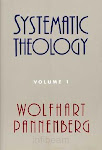Though much of what I read in Pelikan’s first volume was familiar content-wise, I did learn a few new things. The first concerned the “parousia” (Christ’s return to earth), the second involved the surprising chronological relationship of some major doctrines (infant baptism, virgin birth, original sin), and the third regarded the Byzantine emperor Justinian (482/3–565) as “a theologian”.
The delay of Christ's return
The first generation of Christians was expecting the imminent return of Christ within its own lifetime. When it became apparent that this would not happen, they were very much “shocked” – or so I have always thought. But Pelikan says this is not the whole truth.
 “It would be a gross exaggeration of the evidence to describe the eclipse of the apocalyptic vision as ‘catastrophic’ for the generation that followed the apostles. Any such description is based on too simplistic a view of the role of apocalyptic in the teaching of Jesus and in the life of the church. Nor is it corroborated by later texts, for one looks in vain for proof of a bitter disappointment over the postponement of the parousia or of a shattering of the early Christian communities by the delay in the Lord’s return.” (p. 123–4.)
“It would be a gross exaggeration of the evidence to describe the eclipse of the apocalyptic vision as ‘catastrophic’ for the generation that followed the apostles. Any such description is based on too simplistic a view of the role of apocalyptic in the teaching of Jesus and in the life of the church. Nor is it corroborated by later texts, for one looks in vain for proof of a bitter disappointment over the postponement of the parousia or of a shattering of the early Christian communities by the delay in the Lord’s return.” (p. 123–4.)What the texts do suggest is “a shift within the polarity of already/not yet and a great variety of solutions to the exegetical and theological difficulties caused by such a shift” (p. 124).
What is more, the evidence suggests that the hope for Christ’s return did not eclipse as quickly and as completely as some theologians have indicated in the past. Lastly, there is “striking evidence not only that the millenarian hope continued in the church after the apostolic age, but also that, probably from the beginning, it stood in tension with other descriptions of the reign of Christ, which were not as privy to the details of the timetable for this reign.” (p. 125.)
Why do we believe this?
Then to the second piece of new understanding I received. I, like presumably many other Christians, have always thought (subconsciously or consciously) that the doctrines/teachings of the virgin birth of Jesus and of infant baptism developed upon a prior understanding of the fall and original sin. Human nature carried the consequences of Adam’s fall (original sin), and thus, because Christ was a perfect (sinless) human being, he had to have been vouchsafed from original sin (hence the virgin birth) and mankind could be cleansed of it through baptism (hence infant baptism).
Pelikan, however, argues that this is not the case: first came the practice of infant baptism and the belief in the virgin birth, then came the speculations and teachings about the fall and original sin.
“Two themes from the cultus [life and practice of the church] probably deserve to be singled out for their bearing upon the dilemma of Christian anthropology: the confession of the virgin birth of Christ and the practice of infant baptism.”
He continues: “Both themes were present in the life and language of the church before they were ever exploited for their anthropological import; at least there appears to be little or no warrant, on the basis of evidence available now, to argue that they were derived from a previously defined theory of the fall and original sin. But given their increasingly secure place in cultus and confession, they became the premises from which conclusions could be drawn about the fall and original sin.” (p. 286.)
Emperor of Byzantine, Justinian I
Third and last on my “something new” list is Justianian I, emperor of Byzantine. I must confess that I knew nothing of him prior to my engagement to Pelikan’s monographs.
Least of all did I know that he could be described “[i]n many ways [as] the most representative spokesman for catholic orthodoxy in the East” (p. 341). Not only because he was a “Christ-loving Christian emperor”, but because – and here Pelikan quotes H. Beck – in Justinian, “as hardly ever again in a Byzantine emperor, politics, administration, and theology are combined” (p. 341).
Some may find this description appalling and sinister; I find it inspiring.
Other authoritative sources tell me that he is considered a saint in amongts Eastern Orthodox Christians, and is also commemorated by the Lutheran Church.







No comments:
Post a Comment